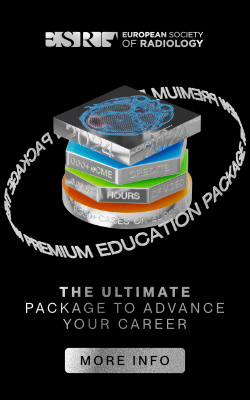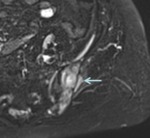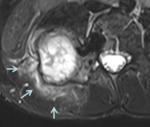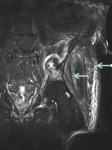Purpose
Percutaneous image-guided cryoablation is used to destroy tumoral cells.
Its safety and efficiency for the treatment of painful bone metastases hasrecently been reported in a prospective and multicenter trial [1].
Local and systemic complications of cryoablation in general have been described,
particularly after hepatic cryotherapy [2-4].
The effect of bone cryoablation on surrounding muscles involved in the ice-ball has not been reported.
The objectives of this poster are:
To evaluate the incidence of muscular thermal injury following bone tumour cryoablation
To relate MRI findings to...
Methods and Materials
Between January 2010 and October 2012,
we retrospectively analysed 24 bone tumoral lesions (16 in the pelvis,
3 in the shoulder and 5 paravartebral lesions) in 21 patients (mean age 53.8 years;11 females) treated by image-guided percutaneous cryoablation and followed-up with MRI.
MRI was performed 28.5 ± 15 days after the cryotherapy.
Muscular T2 STIR hyperintensity was taken to represent an inflammatory myositis,
and graded as follows:
–Grade 0: no myositis
–Grade 1: local myositis (figure 1)
–Grade 2: less than the half volume of...
Results
Muscular T2 STIR hypersignal was observed around the cryoablation site in 83.3% of cases (Grade 0 in 12.5%; Grade 1 in 45.8%; Grade 2 in 20.85%; and Grade 3 in 20.85% respectively).
The final intramuscular ice-ball volume measured after cryoablation and the grading of myositis (Grade 0 = mean volume 2.8 cm3; Grade 1 = 9.2 cm3; Grade 2 = 17.1 cm3,
and Grade 3 = 41.6 cm3) were positively correlated (r=0.64) (figure 7).
Only two cases were symptomatic,
presenting with a different pain than...
Conclusion
Final CT scanner intramuscular ice-ball volume and MRI T2 STIR hypersignal is well correlated.
Muscular thermal injury around the cryoablation probe is commonly observed,
and probably corresponds to an inflammatory myositis.
It is usually asymptomatic,
but when the patient complains of a new pain after cryoablation,
radiologists and clinicians have to think about this diagnosis.
Administration of anti-inflammatory drugs results in resolution of symptoms.
References
1.
Callstrom MR,
Dupuy DE,
Solomon SB,
et al.
Percutaneous image-guided cryoablation of painful metastases involving bone.
Cancer 2012.
doi:10.1002/cncr.27793.
2.
Webb H,
Lubner MG,
Hinshaw JL.
Thermal ablation,
Seminars in Roentgenology.2011;46(2):133–141.
3.
Sandomirsky M,
Crifasi JA,
Long C et al.
Case report of fatal complication in prostatic cryotherapy.
First reported death due to argon gas emboli.
Am J Forendic Med Pathol.2012;33(1):68-72.
4.
Bagia JS,
Perera DS,
Morris DL.
Renal impairment in hepatic cryotherapy.
Cryobiology.1998;36:263-267.




